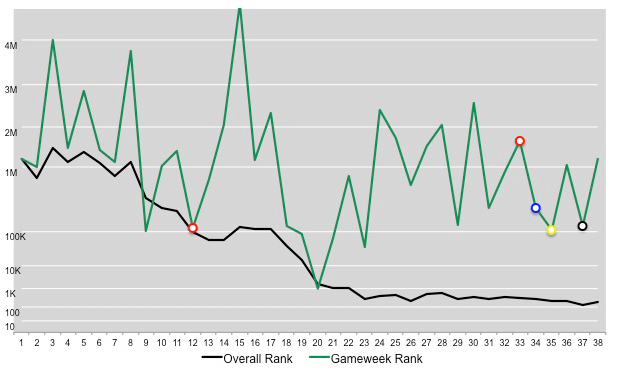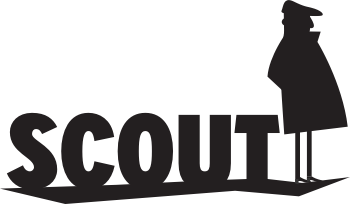Managing by Committee
“We will delegate by discussion,” said Roy Evans confidently at the appointment of fellow Liverpool manager Gerard Houllier in July 1998. For the first time in their history Liverpool had joint managers.
However the experiment was short lived, with Evans departing before the year was out. At his final press conference Evans claimed he didn’t want to be a “ghost on the wall” haunting the now sole manager of Liverpool, Houllier.
Houllier later explained: “The players like to be able to refer to one manager. The concept [of joint managers] was obviously extremely difficult for them.”
Thankfully in FPL we don’t have to manage the precious egos of highly paid sportsmen each week. We aren’t faced with having to explain to Paul Pogba why he’s not in our team even though his price is a relatively modest £8.1m, or tell Mo Salah we are having blasphemous thoughts of selling him because we are worried he doesn’t offer value.
So perhaps the concept of joint management could work better in the fantasy version of football?
This article is about what happened when a group of FPL managers from the Fantasy Football Scout community decided to run a single team. By combining their FPL knowledge and wisdom into one, would they be a success or would they just end up arguing over who to bench and ultimately fall out?
To answer that question let’s start with a look at another experimental FPL team.
Collective Intelligence vs Artificial Intelligence
Featured on the BBC in May, Squadguru is the Artificial Intelligence (AI) algorithm created by Dr Gopal Ramchurn and Dr Tim Matthews from the University of Southampton. Using “Bayesian Machine Learning techniques and a combinatorial optimisation algorithm to optimise team selection”, last season Squadguru finished with 2,270 points and was placed 30,929 out of 5,910,135 players.
This sounds impressive but how did the AI team fare against the joint-managed or Collective Intelligence (CI) team run by members of the Fantasy Football Scout community?
In a word, badly.
The CI team finished a mightily impressive 345th overall with 2,410 points.
Humans 1 – Bayesian Machine Learning 0.
It’s always satisfying to beat the Germans. (And even teams that only sound German.)
Not only did the CI team soundly beat the AI team by 140 points but, out of the 32 managers who formed part of the management collective, 23 also beat the AI with their individual sides.
So who are this talented (and handsome) bunch of Fantasy Football addicts?
Introducing ‘The Cønts’
All members of Fantasy Football Scout, we (yes, I am one of them) include FPL managers from 14 different countries ranging from such diverse places as Bermuda and Serbia to Pakistan and India, France, Sweden and Norway. There’s a Pole and a Bulgarian, a Belgian and a Canadian, not forgetting the odd Brit, Irishman, and American too.
We range in age from 18 to 56, and amongst our number we count A-level students and CEOs, teachers and psychologists, entrepreneurs and DJs. Even a former professional footballer and the Community Manager at FFS. All united by our love for FPL.
Formed by AbuBakar Siddiq (aka TheFantasyFreak) two seasons ago, this motley crew includes a fair dose of FPL pedigree. AbuBakar himself finished a remarkable 4th overall in the 2014/15 season and three more members have also recorded ranks in the top 100 – Utkarsh Dalmia (aka Zophar), Geoff Dance (aka Geoff), and LateRiser12.
Last season’s best placed manager Matt Kearney (aka Bowstring the Carp) narrowly missed out on a two digit finish, ending the campaign in 126th place (blame the Scoutcast curse!). Matt was the only member of the group to finish higher than the Cønts team – our name for the joint-managed side.
Why the name ‘Cønts’? It simply encapsulates what a lovely bunch of people we are and the admiration we hold for an ex Chelsea manager. Although I’m not quite sure about the significance of the Scandinavian letter ø, I have to admit.
Inevitably, this being 2018, we all communicate via WhatsApp. Mixed in with the banter we use WhatsApp to discuss our teams and the latest football news.
How Did The Cønts Team Come About?
“The original idea to manage one FPL team was born in the 2016/17 campaign”, explains United fan Jan Sienkiewicz (aka JØ), the main driving force behind the Cønts team. “One of our members had health issues and, not having the time to manage his own team, he decided to leave his ‘dead’ team for us to manage.”
Mercifully our comrade is alive and well, only his FPL team suffered temporary ‘death’. JØ continues:
“We made the decisions for his team for the rest of the season with brilliant results, even though most of the transfers were usually last-minute. At the end of the campaign, I came up with the idea of setting up a separate team – we wanted to check whether [our success] was a one-off scenario.”
How Did We Do So Well?
One of the key differences between the joint-managed Cønts team compared to our individual teams is that we don’t particularly care about the Cønts team. It’s often an afterthought.
Our individual teams matter to us – we can agonise over decisions, worry about prices rises, and have been known to get upset when we have a bad gameweek.
We are passionate about FPL. We invest a lot of time in it – in addition to web forums a number of the group are active on social media, a few like Johannes Nessa (aka Niemi) and myself contribute community articles to FFS, Jake Conyard (aka Lawro) helped organise last year’s Community Watch Tournament, Jonathan Kahn (aka JK) writes for It’s Round and White, Matt runs his own blog, Zophar writes articles for Fantasy Football Fix, and John Lambert (aka Jossy) has created an FPL planner for Fantasy Football Hub.
We aim to be good FPL managers. In David Wardale’s excellent book ‘Wasting Your Wildcard’, Peter Blake (not a Cønt) describes good FPL managers as ‘the ones that intake a lot of data from multiple sources, which can include watching players on the pitch, listening to managers in press conferences, utilising communities’ collective knowledge (the “wisdom of the crowds” approach) and statistical analysis.’
The Cønts team is the beneficiary of this research. Before each deadline we distil our collective wisdom into making decisions for the team. We normally draw up a shortlist of suggested transfers and vote for our preferred moves.
What’s also crucial is that we don’t overthink our transfers. We want the Cønts team to reflect the group and so we invariably make the most popular or template move the group has made that week. We end up with fairly safe obvious picks.
The Benefits of Collective Decision Making
The fact we don’t particularly care about the Cønts team is important. It means we don’t worry about price rises or team value, we don’t get upset when our new signing blanks or when our captain doesn’t deliver.
Don’t get me wrong – we aren’t going to take loads of hits simply because the Cønts team doesn’t matter. We want to do as well as we can but our hearts will never rule our heads.
This knowledgeable yet dispassionate approach means we sidestep a number of traits that can hamper decision-making.
For instance, hardwired into us not only as humans but as primates is a fear of losing. We hate losing. It’s been proven that we feel losses twice as much as we feel gains (Kahneman & Tversky) and this can push us to make bad decisions.
In FPL it doesn’t get much worse than missing out on a player when he hauls. Even famously patient FPL managers like Ville Rönkä have been known to succumb to impulsive rage transfers simply to ease the pain of lost points.
This will never happen with the Cønts team because it is not run by an individual. The group never makes an early transfer, let alone a rage transfer.
In his TED talk Dan Gilbert highlights a number of reasons why individuals make bad decisions. He shows that we are enormously impatient. According to Dan Gilbert, people will always chose to have $50 now rather than wait a month and have $60.
We all agree that ‘more is better than less’ and ‘now is better than later’, but we find it hard when these two rules conflict. In FPL, having patience in a player is sometimes the better move. And it is much easier to show patience when you are less emotionally affected by the outcomes, as with the joint managed Cønts team.
Another error individuals tend to make is to compare the value of an item to the past. As all good salesmen know people love a discount. When a holiday to Hawaii is offered for $1,600 instead of $2,000 most people will agree that it’s a good deal.
However when the same holiday is offered for $700 we would be disappointed to find that it had gone up to $1,500 by the time we pay for it. As Gilbert points out: “a good deal that used to be a great deal, is not nearly as good as an awful deal that was once a horrible deal”.
In FPL this can affect our perception of a player – either one that has risen substantially in price, or one that has changed position from the previous season. Last year Crystal Palace’s Wilfried Zaha and West Ham’s Marko Arnautovic were both great deals as midfielders, can we expect the same amount of points now they are classified as forwards?
In both cases – a price increase or a position change – simply because a player isn’t a great deal now doesn’t mean he isn’t good value.
It can be a combination of these biases – loss aversion, impatience, errors in comparison – that help explain behaviour like bandwagons or buying players early so we don’t miss out on price rises. While these are not necessarily bad moves they are not always the best moves either.
As Matt pointed out when interviewed last year: “It’s all risk calculation and you need a clear head to do that.” The Cønts team, because it is a dispassionate collective effort, has that clear head.
Analysing the Season
As you can see from the graph below the Cønts team didn’t have the best start last season, and experienced some fairly erratic gameweek ranks. 
The vertical scale is from rank 1 to 4.5m. The distance between the ranks corresponds to the number of points separating them. For instance there are 299pts between rank 1 and rank 100k and 191pts between 100k and 1m. The graph gives an idea of how difficult it is to move up the ranks as you near the summit.
I’ve added markers to show when we played our chips; Wildcards in Gameweeks 12 and 33 (red), Bench Boost in Gameweek 34 (blue), Free Hit in Gameweek 35 (yellow), Triple Captain in Gameweek 37 (black).
In the second part of this article I will analyse our successful season in detail. Discover how we moved from outside the top one million in Gameweek 8 to finish narrowly outside the top 100 by Gameweek 38.

